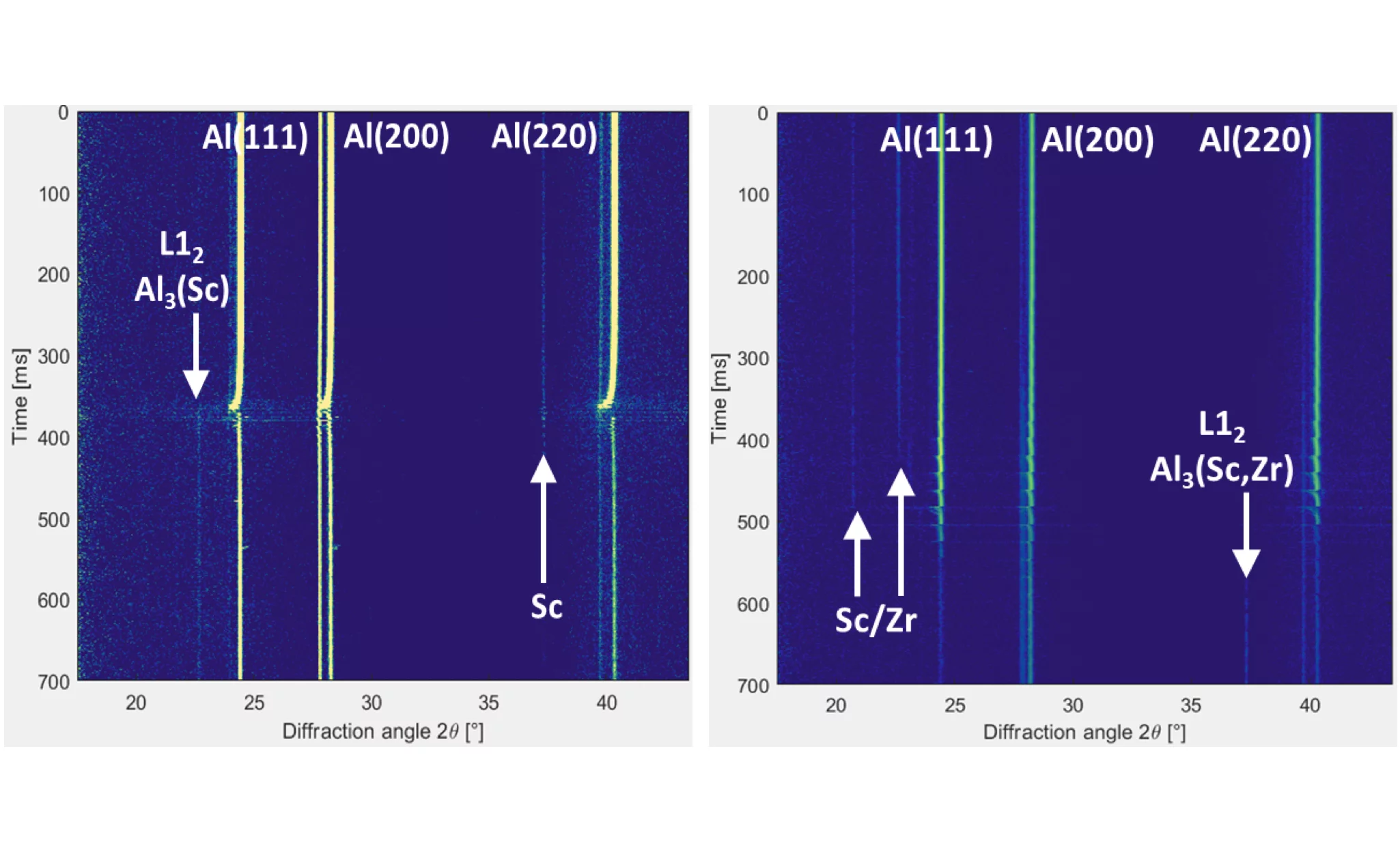The reaction of elemental scandium and zirconium powders with liquid aluminum is observed directly via operando X-ray diffraction during laser 3D printing. This work demonstrates that elemental blends can be used to create fine-grained crack-free Al-alloys and highlights the importance of feature size.
Most powder-bed additive manufacturing (AM) processes use pre-alloyed powder, in which each powder particle contains all constituent elements in the same ratio as in the final alloy. This technique is cost-efficient for industrial-scale production of parts with optimized compositions, but not for the alloy design process, which may require many iterations of different elements in different ratios. An alternative AM approach uses mixed elemental powders.
Laser powder bed fusion (LPBF) is the most commonly used AM technique for 3D printing of aluminum alloys. Prior work showed the dissolution and reaction process during single-line prints of elemental blends of Al-Sc, Al-Zr, and Al-Sc-Zr to create compositionally- and microstructurally-homogeneous dilute alloys, expanding the ability to design precipitation-strengthened Al-based alloys from elemental blends.
In a collaborative effort, researchers from Northwestern University and the Paul Scherrer Institute have performed operando X-ray diffraction experiments during layer-wise printing of bulk Al-based samples. The experiments were performed with a miniaturized 3D printer at the MicroXAS and MS beam lines of the Swiss Light Source. Diffraction patterns were recorded during in situ alloying with a frame rate of 20KHz.
These complex experiments reveal that, upon laser melting, an elemental blend of Sc, Zr, and Al powders reacts within 300 µs to create L12-Al3(Sc,Zr) precipitates. Reaction occurs when the Sc and Zr particles reach ~400-650 °C (well below their melting points), indicating that solid Sc/Zr reacts with molten Al, likely via dissolution/precipitation.With other words, melting of the Sc/Zr particles (at 1541 and 1855 °C) is not necessary, consistent with the exothermic nature of the reaction
In order to study a potential size effect, samples with sizes from 1 mm2 up to 16 mm2 were printed. The long axis of the grains decreases from 10 µm for the smallest sample to 2 µm for the largest samples. This is consistent with the results from the operando experiments, which showed that the maximum cooling rates in the largest samples are about a factor of 2 higher compared to the smallest samples. A slower cooling rate leads to larger, more elongated grains growing in the direction of the solidification front, whereas a faster cooling rate results in smaller, more equiaxed grains. Also, it was shown that as-solidified alloys exhibit 100-130 nm primary L12-Al3(Sc,Zr) precipitates at the base of the melt pool with elongated columnar Al matrix grains growing in the direction of the solidification front towards the sample surface.
This work shows that elemental blends can be successfully used to create L12-Al3(Sc,Zr) primary precipitates which act as grain refiners in an Al-Sc(-Zr) alloy, even at a very low ratio of Sc/Al and Zr/Al particles (~1:130).
Contact
Dr. Steven Van Petegem
Structure and Mechanics of Advanced Materials
Photon Science Division
Paul Scherrer Institute
Forschungsstrasse 111, 5232 Villigen PSI, Switzerland
Telephone: +41 56 310 2537
E-mail: steven.vanpetegem@psi.ch
Original publication
Operando X-ray diffraction study of thermal and phase evolution during laser powder bed fusion of Al-Sc-Zr elemental powder blends
Jennifer A. Glerum, Samy Hocine, Cynthia Sin Ting Chang, Christoph Kenel, Steven Van Petegem, Nicola Casati, Dario Ferreira Sanchez, Helena Van Swygenhoven, David C. Dunand
Additive Manufacturing 55 (2022) 102806
DOI:10.1016/j.addma.2022.102806


